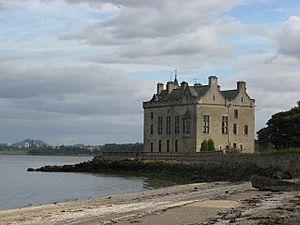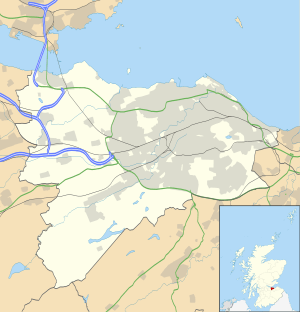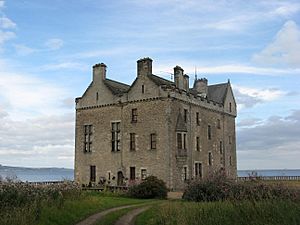Barnbougle Castle facts for kids
Quick facts for kids Barnbougle Castle |
|
|---|---|
| Dalmeny, Scotland | |

Barnbougle Castle on the Firth of Forth, with Edinburgh in the distance
|
|
| Coordinates | 55°59′33″N 3°20′03″W / 55.9924348°N 3.3342916°W |
| Site information | |
| Owner | Earl of Rosebery |
| Condition | Rebuilt 1881, still in use |
| Site history | |
| Built | 13th century |
Barnbougle Castle is an old castle located on the southern coast of the Firth of Forth in Scotland. It sits between the towns of Cramond and Queensferry, near Dalmeny House. The castle is part of the large estate owned by the Earl of Rosebery.
Even though Barnbougle Castle has a history stretching back to the 1200s, the building you see today was mostly rebuilt in 1881. This big renovation was done by the 5th Earl of Rosebery. He was a very important person who even served as the Prime Minister of the United Kingdom from 1894 to 1895.
Contents
What's in a Name? The Meaning of Barnbougle
The name Barnbougle has changed over many years. Some older versions include Barnbughall, Barbogle, and Pronbugele.
Experts believe the name comes from an old British language. It might mean 'shepherd's hill' or 'shepherd's hilltop'. Another idea is 'shepherd's tree'. These names probably refer to the higher ground behind the castle, which looks over the areas where sheep used to graze near the Cockle Burn river.
A Look Back: The History of Barnbougle Castle
The very first building at Barnbougle was a tower house. This was a strong, tall building built in the 1200s by the Mowbray family. The Mowbrays were a powerful family from Normandy who also owned land in Dalmeny and Inverkeithing.
One famous member, Sir John Mowbray of Barnbougle, was a knight. He was honored at the battle of Homildon Hill in 1402.
In 1586, the owner of Barnbougle supported Mary, Queen of Scots. His wife's sister, William Kirkcaldy of Grange, was also a supporter. Two of their daughters even worked for Queen Mary when she was in England.
New Owners and Big Changes
In 1615, the Mowbray family sold Barnbougle Castle to Sir Thomas Hamilton. He later became the Earl of Haddington. The castle was sold again in 1662. This time, it was bought by Sir Archibald Primrose of Carrington. He was a very important judge in Scotland.
Sir Archibald's son, also named Archibald Primrose, was given the title of Earl of Rosebery in 1703. From then on, Barnbougle Castle became the main home for the Rosebery family. Sometime in the 1600s, the original tower house was either rebuilt or replaced.
From Home to Ruin and Back Again
In 1774, a famous architect named Robert Adam drew plans to rebuild the castle. He imagined a triangular building with the old tower at one corner. However, these plans were never used.
By the early 1800s, the castle was falling apart. It was so old that a wave supposedly crashed into the dining room during dinner! Because of this, the 4th Earl of Rosebery decided to build a new family home. This new home, Dalmeny House, was finished in 1817, and the family moved there.
Barnbougle Castle was then used to store explosives. After an accidental explosion damaged it, the castle was left as a ruin.
The Grand Reconstruction
In 1881, Barnbougle Castle was completely rebuilt and made much larger. The plans were drawn by James Maitland Wardrop. The new design was in the Scots Baronial style, which looks like old Scottish castles. Parts of the old castle on the north side were used in the new building.
The main reason for this huge project was to create a special library for Archibald, the 5th Earl of Rosebery. He became Prime Minister in 1894. Lord Rosebery used a special gallery hall in the castle to practice his important speeches.
Today, Barnbougle Castle is still part of the Dalmeny Estate and belongs to the Rosebery family. It is considered a very important historic building.
What Barnbougle Castle Looks Like
The castle is built on a rocky area that sticks out into the water. It uses some parts of the original castle on its north and east sides. But most of what you see today was built in the late 1800s.
The castle has three main floors and an attic. It is made of rough stone with smooth, cut sandstone details. You can see special features like crowstep gables (stair-shaped roof edges) and bartizans (small turrets or towers) with water spouts on the two western corners. It also has a crenellated parapet, which is a wall with gaps like those found on old castles.
On the east wall, there's a stone panel with words carved into it: "Remove Not The Ancient Landmark Which Thy Fathers Have Set. Proverbs XXII.28". In the castle garden, there is also a tall sundial that was moved there in 1890.
Old Stories: Legends of Barnbougle
In 1851, a historian named William Wallace Fyfe wrote down a legend about Barnbougle and a nearby place called Hound Point. The story says that whenever a lord of Barnbougle is about to die, a strange sight appears. A black man and a hound (a type of dog) show up at Hound Point. The man then blows a "death-note" on his bugle (a horn). This is supposedly how Hound Point got its name, from "Bar'n-bugle."
Fyfe was inspired by this story and wrote a poem about a knight named "Sir Roger Mowbray" and his loyal dog. They go on Crusades in the Holy Land. The poem ends with Sir Roger's death and these lines:
- And ever when Barnbougle's lords
- Are parting this scene below
- Come hound and ghost to this haunted coast
- With death notes winding slow.
There are a few different versions of this legend. In some, it's the barking of a hound, not a trumpet, that signals a death is coming.



